Getting noticed online is tougher than ever, and simply writing well isn’t enough to stand out or drive results.
I’ve seen how SEO copywriters bridge the gap between creative messaging and technical optimisation—delivering content that ranks, converts, and stays relevant as search trends shift. If you’ve struggled to get your pages seen or want to sharpen your skills, you’re not alone.
In this article, I’ll break down exactly what an SEO copywriter does, how their role differs from other writers, and which skills matter most. You’ll get a clear look at daily responsibilities, essential tools, and the strategies that actually move the needle.
I’ll also share practical tips for career growth, workflow improvements, and how AI is reshaping the field. By the end, you’ll know how to succeed in this role—whether you’re hiring, upskilling, or aiming to boost your own visibility.
What is an SEO copywriter?
Definition and scope of the SEO copywriter role
Ever wondered what a typical day looks like for an SEO copywriter? It’s far more than writing punchy headlines — it’s where persuasive language meets calculated strategy, all working towards organic traffic and better online visibility. These professionals do more than convince an audience; they make sure every word gets noticed by search engines.
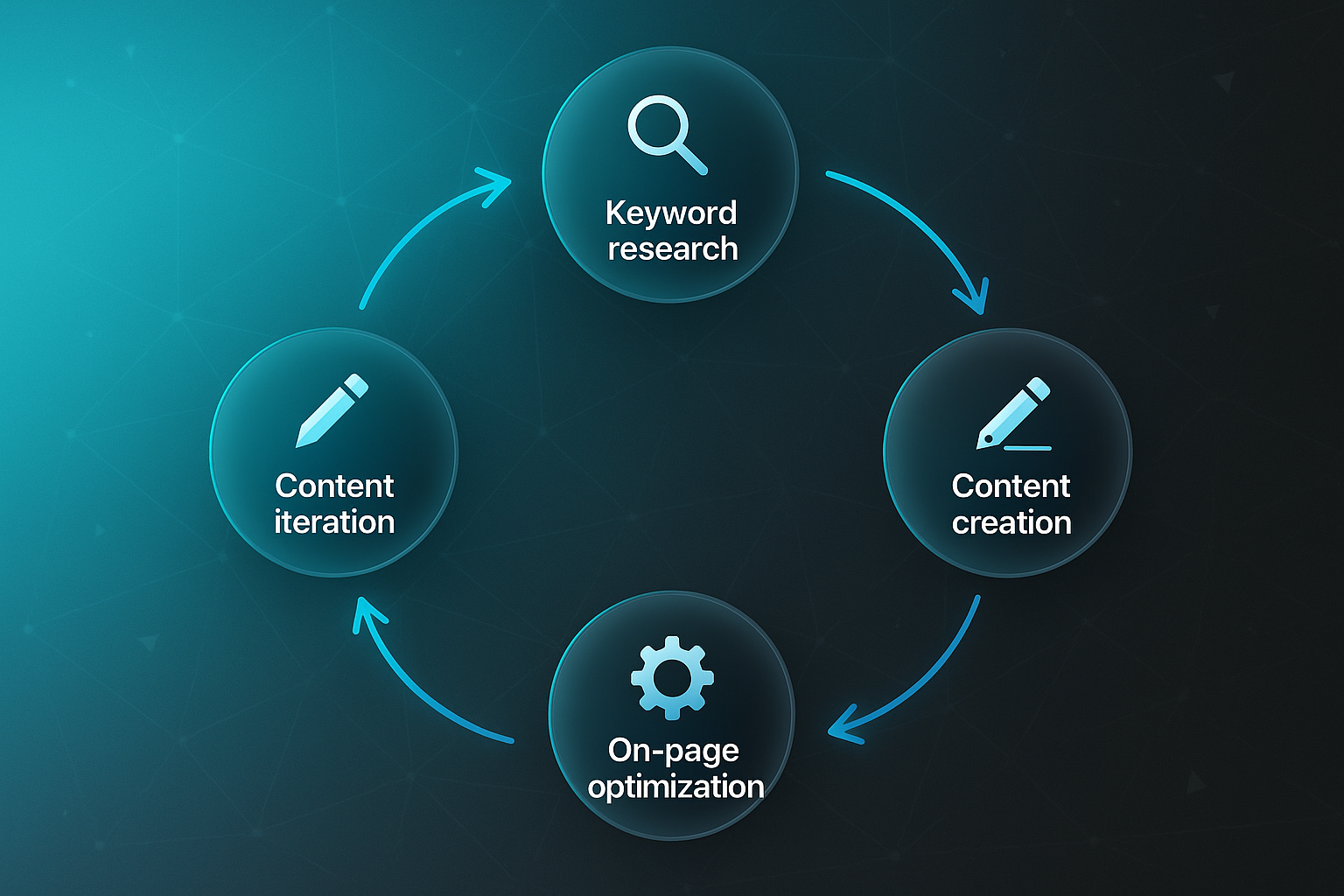
On any given day, they might be diving into keyword research, crafting and refining web pages or blogs, updating headlines for impact, adding compelling calls to action, and perfecting meta descriptions. This blend of creative flair and technical expertise is exactly what sets them apart from the crowd.
And here’s where things get interesting. Their work doesn’t end at publishing content. Analytics tools act as their control centre, tracking traffic growth, keyword rankings, click-through rates, and those precious conversions. However they optimise content, they’re always looking for stronger results.
Take a UK retailer aiming to sell more “wireless headphones.” The SEO copywriter weaves those search terms seamlessly into product pages, shapes clear headings, and tweaks meta tags. After it goes live, they stay alert—monitoring sales, engagement, and rankings, ready to adapt the content whenever results could be improved even further.
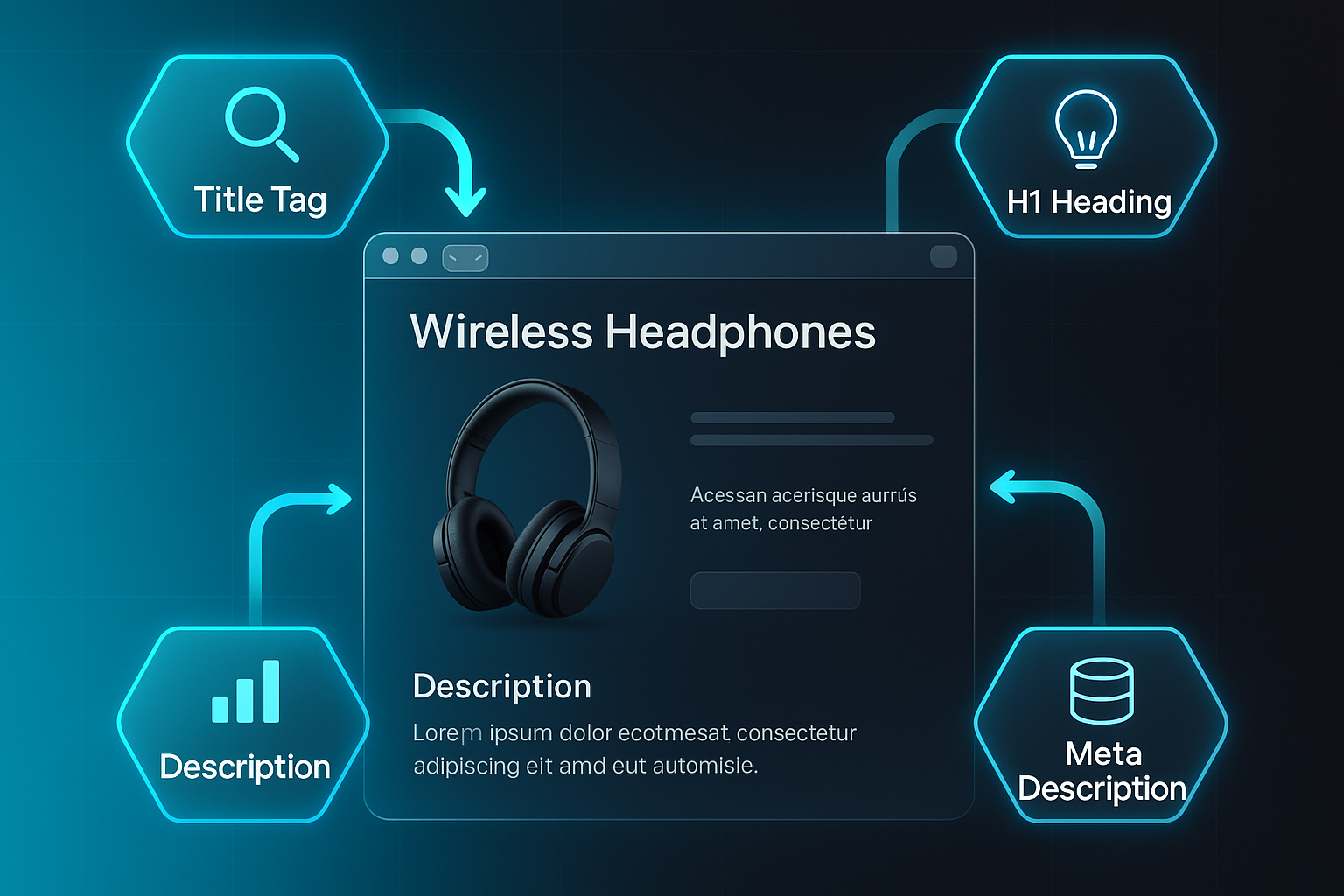
SEO copywriter vs. other writing roles
So, what’s different about this role compared to others? Here’s a quick breakdown:
| Aspect | SEO Copywriting | Traditional Copywriting | Content Writing |
|---|---|---|---|
| Purpose | Search rankings + conversion | Persuade, sell, branding | Inform or educate |
| Style | Keyword-focused, concise, persuasive | Creative, emotive, catchy | Narrative, often explanatory |
| SEO integration | Crucial: keywords, analytics, tags | Rarely relevant | Sometimes, but not central |
| Deliverables | Web pages, blogs, meta data, product listings | Ads, slogans, emails | Guides, articles, emails, newsletters |
Imagine an outdoor brand. The SEO copywriter creates search-ready product pages, like “best waterproof backpack UK.” If a catchy slogan is needed, that’s the traditional copywriter’s specialty.
To maximize marketing effectiveness, you must confidently measure and optimize high-converting channels, creating a clear data-driven link between your discoverability efforts and conversion outcomes.
For in-depth adventure guides, it’s a content writer you’d want.
And here’s the real turning point: only SEO copywriters deliver that hybrid of discoverability and conversion. They’re absolutely instrumental in growing brands in this digital-first marketplace.
Core responsibilities of an SEO copywriter
Keyword research and content mapping
SEO copywriters always begin with research. They explore tools like Ahrefs or SEMrush, hunting down high-value keywords that directly fit search intent and business goals.
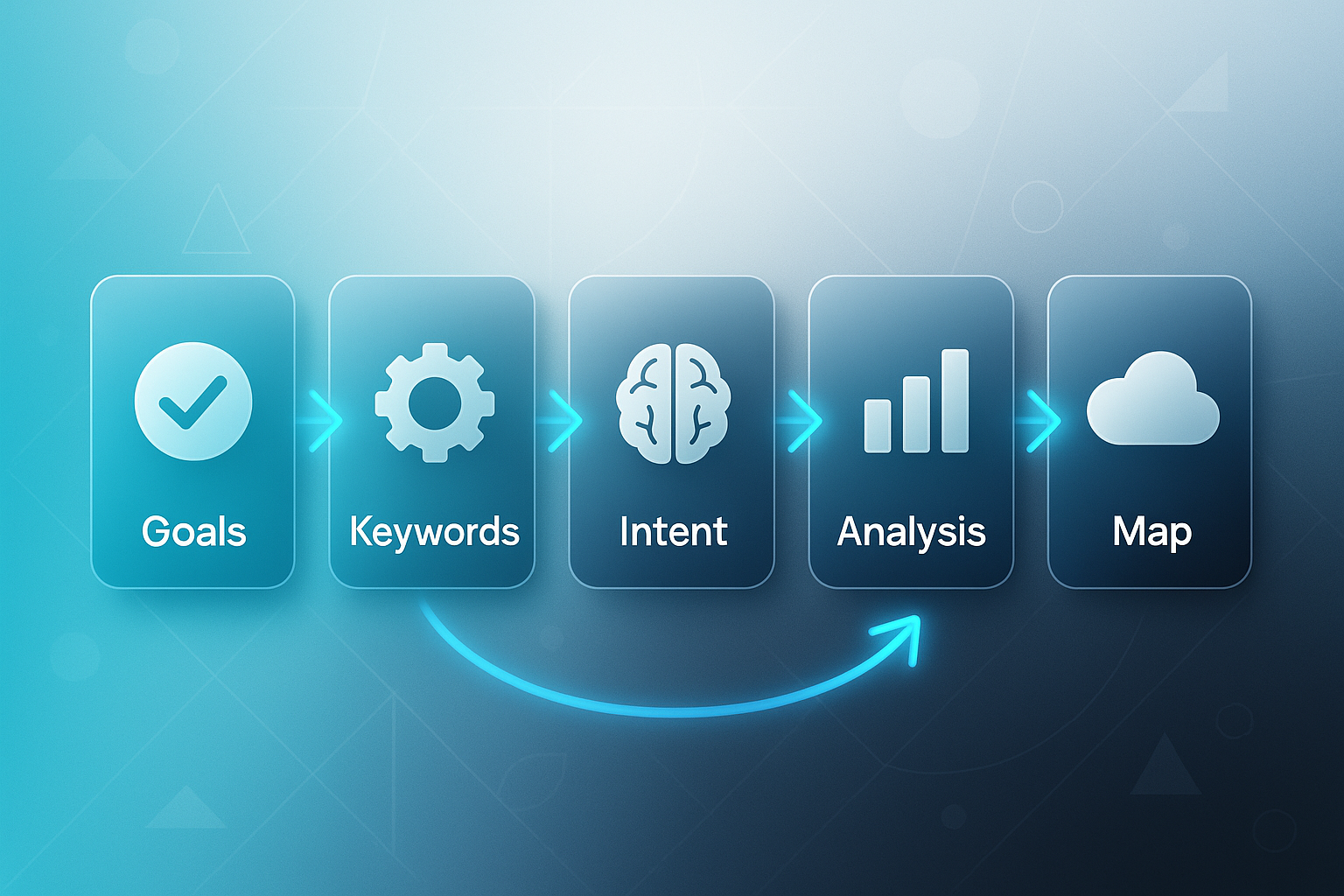
But who are they really speaking to? Are these searchers just browsing, comparing options, or ready to buy right now? That one question steers every bit of their work. By analysing what competitors are doing and keeping a close eye on the ever-changing trends in the industry, they can spot hidden gaps and opportunities others ignore.
All that detective work shapes clever content mapping. Every guide, landing page, or FAQ needs to fit into the user’s journey while building the site’s authority. Imagine it as drawing up a blueprint for discoverability, ensuring each piece of content answers something real searchers are genuinely asking.
What most don’t realise is that mapping isn’t just set-and-forget. Trends move, and so do business priorities. That means continual tweaks to make sure content keeps hitting the mark, both for Google and the audience.
Writing, optimisation, and content maintenance
Then comes the art of writing copy that’s both engaging and laser-targeted for SEO. It’s about threading strategic keywords in naturally—no clunky sentences or word stuffing—while making sure content remains clear and compelling.
They also give careful structure to headings, weave in thoughtful internal links, and make sure image alt text is spot on. Those meta descriptions? Tailored to grab attention on the results page. Calls to action lead visitors towards that next step, baked right into the flow.
But digital content never stands still. As audiences shift and algorithms evolve, older articles are revisited, updated, and polished—fresh statistics or new products added—all to keep every piece both competitive and visible.
The best SEO involves an iterative strategy to account for the deluge of information that is presently available to the end-user. We need to ensure that we are effectively optimizing for users — helping them discover information when they need it, where they need it.
That’s why you’ll find “Top Apps” or similar lists getting regular updates so their rankings stay strong and trustworthy.
Collaboration and performance analysis
Here’s something else you might not expect: SEO copywriters rarely work solo. They collaborate closely with marketers, designers, strategists, and developers. The goal? Making sure every page fits wider branding and technical targets.
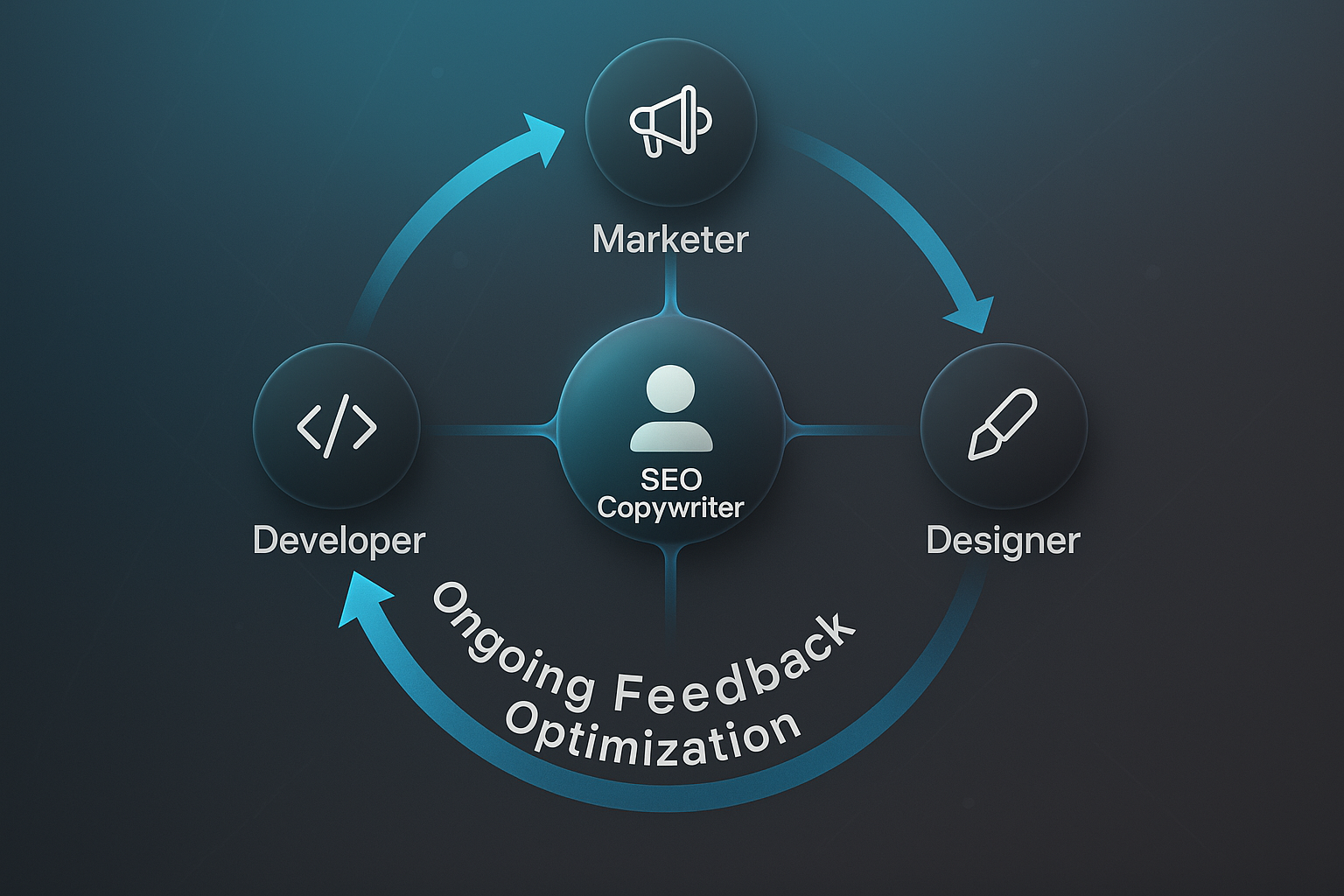
Feedback is an ongoing loop, helping to fine-tune messaging or spark a fresh take on a topic. And performance? That’s tracked relentlessly—think organic traffic, keyword positions, conversions, and engagement.
If click-through rates dip or people stop scrolling, headlines get tweaked, and new creative approaches follow. This continuous process—collaboration, adjustment, and optimisation—means content doesn’t just get published and abandoned.
Instead, it stays at the cutting edge of SEO, actively delivering the results businesses need.
Essential and advanced skills for SEO copywriters
Fundamental SEO and writing skills
Let’s start with the essentials. Every strong SEO copywriter acts as both detective and storyteller—using tools like Ahrefs and Google Keyword Planner to spot relevant keywords and trending search queries.
But simply piling in keywords won’t do. The trick is balancing visibility with writing that truly engages readers. Frameworks help with this. PAS (Problem-Agitate-Solution) captures attention by highlighting a pain point and its resolution, while BLUF (Bottom Line Up Front) ensures main messages come first for scanning eyes.
So, what do the basics look like?
- Metadata optimisation
Craft engaging title tags and meta descriptions, using precise keywords for better clicks and rankings. - Content hierarchy
Provide clear structure with concise headings (H1, H2, H3) to help users and search engines navigate easily. - Internal & external linking
Link to reputable pages and trusted sites, building authority and boosting topical focus.
Analytics and optimisation abilities
Now for what happens after “publish.” Data quickly becomes central. SEO copywriters watch organic traffic and keyword tracking with Google Analytics and Search Console, analysing metrics like bounce rate and click-through rate for clues to improve content.
A/B testing — such as trying different headlines or calls to action — can clearly impact results.
Advanced skills and specialisation
Experienced copywriters don’t stop at basics. They conduct content gap analysis to find unanswered questions and create targeted pages.
By mapping user intent—understanding if visitors want information or are ready to buy—copywriters make sure content matches every point of the audience journey.
Here’s where E-E-A-T (experience, expertise, authority, trust) comes into play. Practical examples, credible insight, and transparent sources all show reliability. If your reach is international, localisation is vital: tailor content to British English and recognise global SEO practices as needed.
Skill progression at a glance
Start with research, writing, and SEO basics. Next comes metadata, structure, and linking know-how. The best use analytics to guide strategy, fill content gaps, and adapt content as technology and trends evolve — because in SEO, learning never stops.
Effective SEO copywriting strategies and workflow
Keyword research techniques and intent alignment
Let’s start with where an accomplished SEO copywriter truly finds their edge—using Ahrefs, SEMrush, and Google Keyword Planner. These tools aren’t just for hunting trendy phrases; they help uncover what people really want and why.
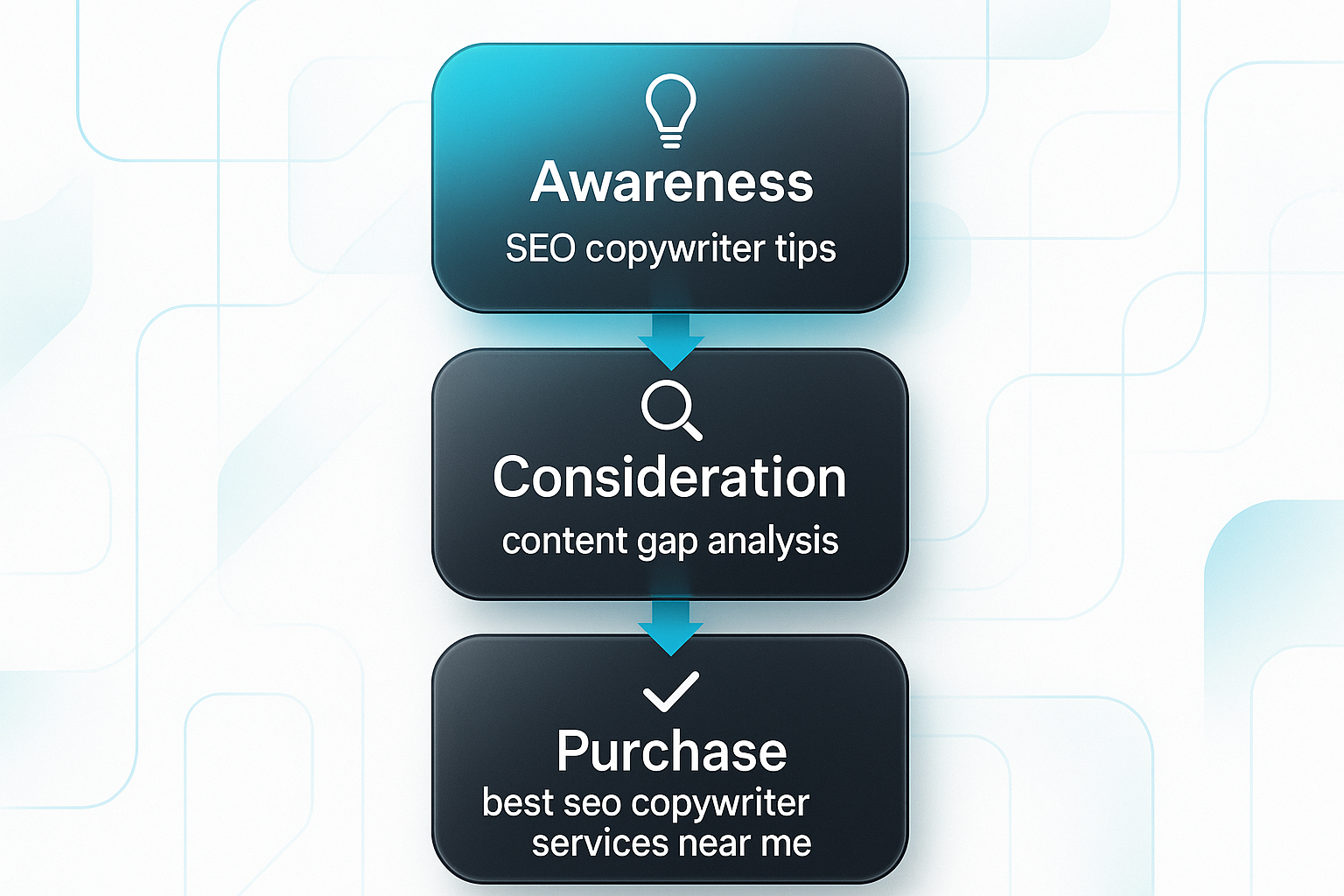
But here’s where it gets interesting: it’s never just about traffic volume. It’s about intent. Choosing a phrase like “best noise-cancelling headphones for travel” captures genuine buyers, not casual browsers. By working with primary, secondary, and especially long-tail keywords, you reach people at every stage—awareness, consideration, and ready-to-buy.
What matters most? That every piece of content directly addresses the actual questions users have at each point, so answers never feel generic or missed.
SERP analysis for competitive advantage
Now, how do you one-up those top-ranking results? Begin with a close look at what’s already earning Google’s favour. Analyse how competitor content is structured, which visuals and formats are used, and, crucially, where they fall short.

Spot gaps—missing guides, old advice, or lacklustre FAQs—and step in with content that makes up for what’s missing. This is how your work becomes the most user-centred and authoritative option on that search results page.
On-page optimisation and engagement techniques
Optimisation in 2024 thrives on clean structure and lively engagement. Make sure your main keyword headlines the H1, fits a subheading, and appears naturally throughout.
Short sections, succinct headings, and bullet points make scanning a breeze. Schema markup (Article, FAQ, HowTo) unlocks rich snippets, nudging your content higher in SERP features. Relevant videos, infographics, or interactive tools boost engagement and keep readers around longer. Add meaningful calls to action exactly where users need direction.
Content performance and maintenance
Remember—hitting publish is only the beginning. Regular content audits are essential, tracking keyword rankings, organic visits, and engagement with Search Console, Analytics, or Ahrefs.
Quarterly reviews suffice for ongoing health, punctuated by annual deep dives. If conversions drop, info ages, or competition surges ahead, update headlines, calls to action, or your data. Prioritise evergreen content; it sustains your authority and search visibility through endless industry changes.
Ultimately, this is the secret behind exceptional SEO copywriting: keeping one step ahead of user intent, competitors, and algorithms—all at once, in a cycle that never stands still.
SEO copywriting versus other writing styles
Traditional copywriting compared to SEO copywriting
What’s the real distinction between an SEO copywriter and a traditional copywriter? While both specialise in persuasion, their goals and their measures of success couldn’t be more different.
- Purpose and tactics
Traditional copywriting plays on emotional cues to sell, but SEO copywriting is crafted to rank well and prompt action. - Typical deliverables
Traditional delivers ads or taglines; SEO produces web pages, product descriptions, and keyword-rich blogs. - Workflows and measurement
Traditional writing delivers quick feedback—think brand impact, sales, campaign buzz. SEO involves research, optimisation, and ongoing results tracking.
Here’s where things shift: SEO copywriting is a long game, built for results that last, with traffic growing over time—sometimes well after content is first launched.
Content writing compared to SEO copywriting
So, how does content writing fit into all this? It overlaps, but the intent and process still set it apart.
- Main focus
Content writing informs, educates, or entertains. SEO copywriting does this and also ensures discoverability. - Output and approach
Content writers produce guides and articles; SEO copywriters focus on landing pages, buying guides, and meta descriptions. - Skills and feedback
Content writers value depth and research. SEO copywriters add technical optimisation and frequent updates.
You could say it’s like a band—each role distinct but all working towards a harmonious brand presence that’s accessible and valued.
Quick comparison for teams and hiring managers
| Aspect | SEO Copywriting | Traditional Copywriting | Content Writing |
|---|---|---|---|
| Purpose | Ranking, traffic, persuasion | Persuasion, branding | Education, authority |
| Deliverables | Web pages, blogs, meta tags | Ads, slogans, brochures | Guides, articles, newsletters |
| Workflow | Keyword research, SEO, analytics | Creative, campaign | Research, clarity |
| Core skillset | SEO, analysis, persuasive copy | Creativity, emotion | Research, explanatory writing |
So, if you’re building a digital team, spotting these differences is crucial—that’s the turning point for impact that reaches both humans and algorithms.
Content optimisation techniques for SEO copywriters
Technical on-page SEO essentials
Heading structure and meta descriptions
Let’s start strong: every piece needs a clear heading structure. Use one H1 with your main keyword, and divide topics using H2s and H3s. These guide readers and search engines smoothly.
Meta descriptions deserve attention. Craft each to be unique, weave in a relevant keyword, and keep it under 155 characters. Add a call to action—a small touch that can genuinely lift your click-through rates.
Internal/external linking, schema markup
Build valuable connections. Add at least two internal links per page, always using descriptive anchor text. Specific anchors direct readers, not bland “read more” text. Link out to reputable sources to add trust.
For extra visibility, include schema markup (like Article, FAQ, or Review schema). This makes your content clearer to Google and can help it stand out in results.
Site speed and mobile optimisation
If a site’s slow, people leave. Compress images, keep scripts minimal, and ensure load times are quick. Responsive layouts and tap-friendly buttons make things easy on mobile. Google’s PageSpeed and Mobile-Friendly tests show how you’re doing.
User engagement and quality signals
Readability, active language, rich media
Short sentences and crisp paragraphs drive engagement. Add bullet points for clarity. Supporting visuals—optimised images, infographics, keyworded alt text—help both SEO and user experience.
Authority signals: sources, quotes, bios
Trust really matters now. Include author bios, cite current reputable sources, and show clear contact details. These E-E-A-T signals (Experience, Expertise, Authority, Trust) force-multiply credibility—and help rankings.
SEO copywriter’s actionable checklist
- Layered headings and unique H1
One H1, logical H2s/H3s, keywords woven in naturally. - Compelling, unique meta descriptions
Under 155 characters, with a call to action. - Strategic internal & external links
At least two internal; clear, descriptive anchors. - Schema markup for rich results
Article, FAQ, or Review schema. - Fast loading, fully mobile
Compress images, responsive layout, check with Google tools. - Readable, engaging layout
Short sentences, bullet points, supporting visuals. - E-E-A-T and transparency signals
Author bios, visible contact info, recent sources.
So, when these tactics are dialled in, your SEO copy isn’t just engaging—it’s ready to win in the search results.
SERP analysis and content planning for SEO copywriters
Steps to analyse SERPs and competitors
Let’s start with the foundation of standout SEO copywriting: sharp SERP analysis. Before any drafting begins, you need to see what claims the top spots in Google.
Pick your target keywords with platforms like Ahrefs or Semrush. Always use Incognito mode and set your location accurately—this strips out any history or personalisation bias from your results.
As the SERPs load, watch for special features—featured snippets, People Also Ask sections, videos, or those magnetic image carousels. Each of these influences where attention goes and shapes how people engage.
Check which competitor domains dominate those search slots. Then, dig into the types of content they use. Are they relying on comprehensive guides, FAQs, or video walk-throughs?
At this stage, it pays to look closely at how top results format meta titles, descriptions, and those all-important headings. Search for gaps: missing subtopics, thin visual content, or poorly targeted keywords.
Leverage analysis tools like Ahrefs or SurferSEO to spot neglected keyword clusters and to monitor how the landscape evolves. SERP analysis isn’t a tick-box—it should become routine, because Google’s results never stand still.
Building effective content briefs from analysis
So, after all this research, what comes next? You translate insights into clear, actionable content briefs.
Outline your primary and secondary target keywords, the user intent, and a headline structure that leans on what’s actually working in the SERPs.
Set your word count goals, specify must-have visuals, add schema markup if relevant, and plan metadata—the meta title, description, and calls to action—drawing inspiration from high-performers.
AI-powered tools like SurferSEO, Clearscope, or SEOSwarm help here by quickly pulling keyword suggestions, grading content, and generating fast outlines.
If you’re part of a team, maintain shared dashboards or project boards so everyone is aligned as briefs shift. And above all, keep revisiting SERPs and competitor pages—because the only way to stay ahead is to adapt as the search ecosystem evolves.
Understanding user intent and filling content gaps
Mapping types of user intent to content
Let’s talk about user intent—it’s the real engine of effective SEO copywriting. People search for different reasons, but most fall into informational, navigational, or transactional categories. If someone’s asking “how to open a business account”, they’re after detailed guides or useful FAQs.
Now, think of “NatWest login”—that’s navigational. For those, clear landing pages or direct support work best. But with “buy running shoes UK”, you’re into transactional territory, so persuasive product pages geared for easy buying are the way to go.
It’s about matching format to intent: guides and FAQs for the curious, landing pages for brand searchers, product listings or reviews for buyers. Even headlines and calls to action should mirror user intent—whether you’re sparking learning, guiding navigation, or nudging that next purchase.
Identifying and addressing content gaps
So, how do you pinpoint what’s missing? The answer lies in competitor research and SERP feature analysis. SEO tools like Ahrefs or SEMrush show which topics, keywords, or formats your site hasn’t covered yet. When you see rivals using tables or bulleted lists to earn featured snippets, add those tactics—Google loves clarity.
This strategy pays off. Picture a UK finance site that added a mortgage calculator and a Q&A section after spotting gaps; their traffic and rankings rose noticeably. Target zero-click searches and featured snippets by creating concise lists and direct answers. Proactively filling those gaps and matching intent isn’t just ticking a box—it’s the turning point to outperform competitors and boost visibility.
Blog-in-one-minute
Add a fully SEO-optimised blog to your website with just 2 lines of code.
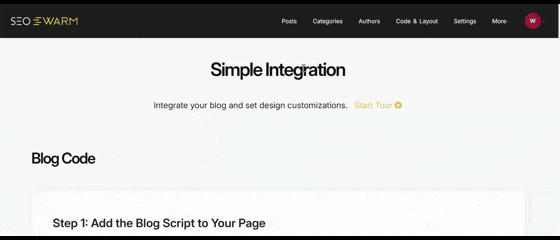
Business outcomes, authority, and measuring SEO copywriting success
Driving traffic, conversions, and authority
Let’s talk about results—because that’s the true measure of any SEO copywriter’s impact. Strategic internal linking and targeted calls to action are the secret weapons, guiding visitors to high-value pages and boosting vital metrics.
Picture this: ecommerce brands that reworked links between guides and products, pairing them with stronger CTAs, saw clear spikes in weekly visits and more checkouts. In B2B, bold CTAs on service pages directly delivered more qualified leads.
Why does this matter? Nearly 46% of UK marketers credit SEO optimisation for campaign wins—clear proof that well-constructed copy is driving conversions and growth.
But here’s the bigger picture: E-E-A-T (Experience, Expertise, Authoritativeness, Trustworthiness) is now at the heart of long-term authority. SEO copywriters build this by delivering credible, well-sourced content, complete author bios, and links to trusted sources.
Sites that truly showcase credentials attract featured snippets, better backlinks, and steady lifts in quality traffic. This authority-first approach gets rewarded—by both search engines and real people.
Success metrics and performance analysis
So, how do you know it’s working? Prioritise traffic growth, improved keyword rankings (top ten and rich snippets), and conversion numbers. Tools like Google Analytics and Semrush flag new chances and track ROI as you go.
Even small updates—like adding stronger CTAs or updating keywords in onboarding guides—can deliver up to 3x more traffic. Regular reviews of bounce rates, time spent, and conversions spotlight when it’s time to refresh.
In a nutshell, analytics-led improvements force-multiply your results and prove just how instrumental great SEO copywriting is for real business success.
The impact of AI, automation, and evolving trends in SEO copywriting
How AI and automation are reshaping workflows
AI-powered tools aren’t just an add-on anymore—they’re now at the centre of SEO copywriting. They handle the heavy lifting of keyword research, topic ideation, optimisation, and direct publishing.
In one model of human-AI collaboration, the AI system generates a first draft or a starting point, and the human creative professional refines and improves it.
This gives copywriters more space to focus on strategy and creativity—where the magic really happens. Natural Language Processing (NLP) makes editing and slick keyword placement quick and seamless, right into CMS platforms.
Automated systems generate content briefs, suggest smart structures, and keep updates flowing. The real benefit? Agencies and freelancers get to scale output, all whilst holding on to consistently high standards.
Automated research, optimisation, and publishing
- AI-driven keyword and topic discovery
AI clusters keywords and uncovers research gaps quickly, saving hours of manual work. - Machine learning-guided content editing
Get instant suggestions to fix meta tags, tweak headings, and refine keyword flow. - Automated publishing and performance tracking
Deploy content directly—with real-time analytics for ongoing improvement.
Freelancers using these platforms can turn out more pieces with better rankings and engagement.
SEOSwarm and modern agentic solutions
Now, platforms like SEOSwarm step things up. These systems cover the entire SEO copywriting cycle—research, writing, optimisation, and maintenance—all orchestrated with agentic precision.
And because they adapt with Google’s changing rules, you always stay ahead. Real-time analytics and automated updates guarantee content doesn’t slip out-of-date or lose its punch.
Features: blog-in-one-minute, flawless optimisation, analytics, maintenance
- Instant blog launches
Create and publish fully-optimised posts in under a minute. - Multi-agent content validation
Smart agents check technical accuracy and keep your brand tone on track. - Live analytics and automated maintenance
Dashboards monitor health, prompt updates, and flag ranking dips. - Seamless integrations
Slots directly into your CMS and analytics for efficiency.
Benefits: quality, scalability, cost-effectiveness
- Quality assurance and consistency
Automation upholds accuracy and strong E-E-A-T with every piece. - Scalable content creation
Effortlessly ramp up output without quality trade-offs. - Cost savings for all business sizes
Even small teams gain enterprise-level SEO without breaking budgets.
With SEOSwarm, a tiny crew can take on more clients whilst still keeping up those top-tier rankings.
Adapting to zero-click, evolving SERPs and tech advancements
SERPs now favour zero-click and interactive features—so, strategies must evolve fast. Visibility hinges on snippet-ready writing and schema markup.
Strategies to remain visible and relevant
- Optimise for direct, concise answers
Use question-style headings and punchy responses to win snippets. - Implement structured data/schema markup
Schema boosts rich SERP features and trust. - Automate SERP monitoring and refreshes
Let platforms flag trends and prompt fast updates. - Blend AI insight with human oversight
Smart automation + editorial finesse ensures consistent performance.
Embracing new tools and approaches keeps copywriters and agencies seen, trusted, and ready—no matter how search (or Google) changes next.
Practical career development for SEO copywriters
Learning and professional development
So, how does an SEO copywriter actually level up? Structured learning is the foundation. You want to aim for well-known courses—think SEMrush, HubSpot, or Yoast Academy. These programmes cover everything from keyword research and intent analysis to metadata and persuasive copywriting. Certifications from places like Google Analytics add instant credibility, especially for freelancers or anyone looking to impress agencies.
Self-study matters just as much. Make a habit of dissecting high-ranking articles, following top SEO blogs for fresh tactics, and tinkering with your own optimisation techniques. Tracking your personal progress is surprisingly powerful—document KPIs, before-and-after search ranks, and client feedback. This gives you tangible proof of growth, and helps map out your next steps.
Specialisation and workflow optimisation
Niche focus and automation
Now, here’s where things get interesting. By specialising—say, in local SEO, multilingual campaigns, or sectors like technology or healthcare—you instantly boost your market value. Target what’s in demand and create portfolio samples tailored for that audience. Streamlining your workflow is instrumental too. Use automation tools like Ahrefs, SEMrush, or agentic writing platforms to speed up research and free up time for the true creative work. Partner closely with marketers and developers; collaboration is often the catalyst for break-out campaign results.
Actionable career boosters
- Portfolio site
Showcase concrete results and niche experience. - Guest posting & freelance
Broaden your horizon and gain fresh authority. - Networking
Meet the industry where it gathers—communities and events. - Continuous learning
Keep refining your skills in line with SEO’s latest shifts.
Essential tools and platforms for SEO copywriters
AI-powered SEO content strategy tools
Let’s start with AI-driven platforms and how they simplify life for SEO copywriters. Tools like SEOSwarm automate keyword research, outlines, drafting, optimisation, and analytics.
Freelancers benefit because repetitive admin disappears, letting them focus on strategy rather than grunt work. Agencies win too, getting centralised project management and automated content updates for smoother team collaboration.
Automation is key—it monitors ranking shifts and flags when trends change. That leaves room for more creative copywriting and focused planning.

AI-Powered Content Strategy
See the AI platform that's replacing entire content teams (with better results).

Advanced keyword and content platforms
A modern toolkit includes SurferSEO for real-time optimisation and Clearscope’s semantic analysis. Jasper brings AI-driven drafting, while MarketMuse creates targeted briefs and topic audits.
Entry-level users get instant feedback, while agencies love the collaboration and bulk audit features. A typical workflow starts with MarketMuse for briefs, drafts in Jasper, then optimises with SurferSEO or Clearscope, finishing with SEOSwarm’s technical checks and publishing.
How to choose and integrate tools for workflow
So how do you choose? Match tools to your budget, skill level, and workflow.
Plugins are ideal for solo writers, while teams may opt for robust APIs and automation. Keep testing new integrations and review your stack often—automate the routine, and dedicate your time to strategy and powerful results.
What Makes a Great SEO Copywriter
Most people think SEO copywriting is just about keywords, but the real value lies in blending strategy, creativity, and constant adaptation. The best SEO copywriters don’t just write—they analyse, collaborate, and iterate, always aligning content with user intent and business goals.
If you want to succeed in this role, here’s my advice: - Master keyword research and SERP analysis - Build a workflow that includes regular content audits and updates - Embrace AI tools to streamline research and optimisation - Prioritise E-E-A-T signals and user engagement - Keep learning—SEO never stands still
Every update, every tweak, and every insight moves your content closer to the top. In SEO copywriting, the winners are those who treat every page as a living asset—measured, improved, and never left behind.
— Wil








